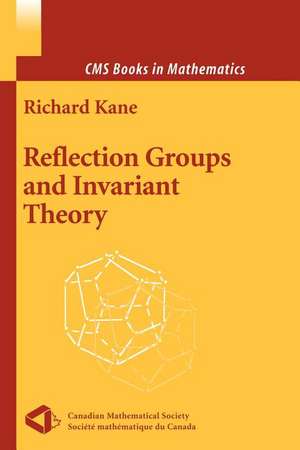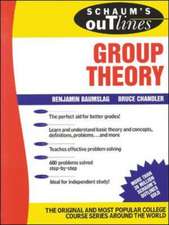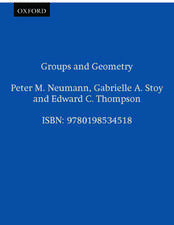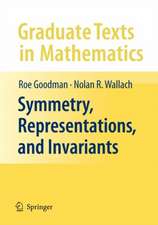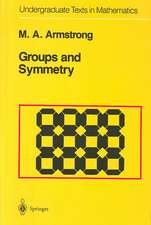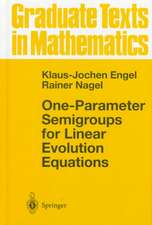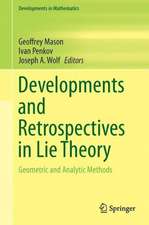Reflection Groups and Invariant Theory: CMS Books in Mathematics
Autor Richard Kaneen Limba Engleză Paperback – 9 oct 2011
Richard Kane is a professor of mathematics at the University of Western Ontario. His research interests are algebra and algebraic topology. Professor Kane is a former President of the Canadian Mathematical Society.
| Toate formatele și edițiile | Preț | Express |
|---|---|---|
| Paperback (1) | 493.34 lei 6-8 săpt. | |
| Springer – 9 oct 2011 | 493.34 lei 6-8 săpt. | |
| Hardback (1) | 537.14 lei 6-8 săpt. | |
| Springer – 21 iun 2001 | 537.14 lei 6-8 săpt. |
Din seria CMS Books in Mathematics
- 20%
 Preț: 942.90 lei
Preț: 942.90 lei - 17%
 Preț: 429.86 lei
Preț: 429.86 lei - 15%
 Preț: 787.71 lei
Preț: 787.71 lei -
 Preț: 322.22 lei
Preț: 322.22 lei - 18%
 Preț: 780.97 lei
Preț: 780.97 lei - 15%
 Preț: 690.59 lei
Preț: 690.59 lei -
 Preț: 399.29 lei
Preț: 399.29 lei -
 Preț: 386.00 lei
Preț: 386.00 lei - 15%
 Preț: 644.30 lei
Preț: 644.30 lei -
 Preț: 368.24 lei
Preț: 368.24 lei -
 Preț: 392.37 lei
Preț: 392.37 lei - 18%
 Preț: 784.92 lei
Preț: 784.92 lei - 15%
 Preț: 443.91 lei
Preț: 443.91 lei - 15%
 Preț: 641.20 lei
Preț: 641.20 lei - 24%
 Preț: 698.99 lei
Preț: 698.99 lei -
 Preț: 389.88 lei
Preț: 389.88 lei - 15%
 Preț: 537.23 lei
Preț: 537.23 lei -
 Preț: 400.10 lei
Preț: 400.10 lei - 20%
 Preț: 547.86 lei
Preț: 547.86 lei - 15%
 Preț: 524.88 lei
Preț: 524.88 lei -
 Preț: 395.85 lei
Preț: 395.85 lei -
 Preț: 399.29 lei
Preț: 399.29 lei -
 Preț: 397.01 lei
Preț: 397.01 lei -
 Preț: 391.79 lei
Preț: 391.79 lei -
 Preț: 483.05 lei
Preț: 483.05 lei -
 Preț: 497.00 lei
Preț: 497.00 lei - 15%
 Preț: 645.28 lei
Preț: 645.28 lei -
 Preț: 356.60 lei
Preț: 356.60 lei - 15%
 Preț: 639.41 lei
Preț: 639.41 lei - 15%
 Preț: 648.56 lei
Preț: 648.56 lei -
 Preț: 492.37 lei
Preț: 492.37 lei - 15%
 Preț: 478.05 lei
Preț: 478.05 lei -
 Preț: 389.49 lei
Preț: 389.49 lei - 15%
 Preț: 486.86 lei
Preț: 486.86 lei
Preț: 493.34 lei
Nou
Puncte Express: 740
Preț estimativ în valută:
94.40€ • 98.83$ • 78.11£
94.40€ • 98.83$ • 78.11£
Carte tipărită la comandă
Livrare economică 05-19 aprilie
Preluare comenzi: 021 569.72.76
Specificații
ISBN-13: 9781441931948
ISBN-10: 1441931945
Pagini: 392
Ilustrații: IX, 379 p.
Dimensiuni: 155 x 235 x 21 mm
Greutate: 0.55 kg
Ediția:Softcover reprint of the original 1st ed. 2001
Editura: Springer
Colecția Springer
Seria CMS Books in Mathematics
Locul publicării:New York, NY, United States
ISBN-10: 1441931945
Pagini: 392
Ilustrații: IX, 379 p.
Dimensiuni: 155 x 235 x 21 mm
Greutate: 0.55 kg
Ediția:Softcover reprint of the original 1st ed. 2001
Editura: Springer
Colecția Springer
Seria CMS Books in Mathematics
Locul publicării:New York, NY, United States
Public țintă
GraduateCuprins
I Reflection groups.- 1 Euclidean reflection groups.- 2 Root systems.- 3 Fundamental systems.- 4 Length.- 5 Parabolic subgroups.- II Coxeter groups.- 6 Reflection groups and Coxeter systems.- 7 Bilinear forms of Coxeter systems.- 8 Classification of Coxeter systems and reflection groups.- III Weyl groups.- 9 Weyl groups.- 10 The Classification of crystallographic root systems.- 11 Affine Weyl groups.- 12 Subroot systems.- 13 Formal identities.- IV Pseudo-reflection groups.- 14 Pseudo-reflections.- 15 Classifications of pseudo-reflection groups.- V Rings of invariants.- 16 The ring of invariants.- 17 Poincaré series.- 18 Nonmodular invariants of pseudo-reflection groups.- 19 Modular invariants of pseudo-reflection groups.- VI Skew invariants.- 20 Skew invariants.- 21 The Jacobian.- 22 The extended ring of invariants.- VII Rings of covariants.- 23 Poincaré series for the ring of covariants.- 24 Representations of pseudo-reflection groups.- 25 Harmonic elements.- 26 Harmonics and reflection groups.- VIII Conjugacy classes.- 27 Involutions.- 28 Elementary equivalences.- 29 Coxeter elements.- 30 Minimal decompositions.- IX Eigenvalues.- 31 Eigenvalues for reflection groups.- 32 Eigenvalues for regular elements.- 33 Ring of invariants and eigenvalues.- 34 Properties of regular elements.- Appendices.- A Rings and modules.- B Group actions and representation theory.- C Quadratic forms.- D Lie algebras.- References.
Recenzii
From the reviews:
CANADIAN MATHEMATICAL SOCIETY NOTES
"The former group are interested in Lie algebras and algebraic groups while the latter group includes commutative algebraists and topologists. This is the first book I’ve read that is aimed at both audiences, providing a clear exposition of a truly beautiful area of mathematics. It is probably fair to say there isn’t much new in the book, except to find all the relevant material in the one place, well-organized and well-explained…This is a very lovely book to read. I found the pace of the book to be perfect. The approach follows the development of the subject in the literature closely – this is how it was discovered, more or less. It appears to my eye to be accessible to a first-year graduate student. It is not overly terse, nor overly wordy and there are many examples."
ZENTRALBLATT MATH
"The book is certainly a good source of information mainly in the more advanced areas of the subject. The references compile nearly a hundred articles and books."
MATHEMATICAL REVIEWS
"The book is a very accessible introduction to a wonderful part of mathematics that has many applications…it can be pointed out that the approach taken in this book includes examples of the use of Galois theory, Cohen Macaulay properties, Hopf algebras, representation theory and basic algebraic geometry. This is a nice way to see applications of these areas…The book would certainly be a good choice to teach the ideas in the above list, as the book flows very well. Each chapter is well motivated and summarized in its introduction."
"This book by the Canadian mathematician Richard Kane is an elementary exposition of the theory of finite pseudo-reflection groups … . It can be read by a beginning graduate student, it requires almost no prerequisites and never becomes hard to read. … it has a good list of references to the not too recent literature. … All in all it is acarefully written book that can be recommended to a graduate student for independent study, containing a good amount of interesting material." (A. Broer, Nieuw Archief voor Wiskunde, Vol. 6 (2), 2005)
"The main theme of this book is a study of the properties of reflection groups … . The book is nicely organised and written in a very understandable way. The main ideas are clearly explained at the beginning of each chapter, so it is easy to learn the facts first and to fill in the details later, when needed. … The book is pleasant to read, and can be heartily recommended to a general mathematical audience, starting with graduate students." (European Mathematical Society Newsletter, September, 2003)
"This graduate text develops the structure theory of finite reflection groups … . It is worth mentioning that many useful diagrams and tables are included in the text … . Some background information is provided at various places in the text and in appendices on rings and modules, group actions and representations, quadratic forms and Lie algebras. The book is easily readable and informative; thus it can be warmly recommended to every mathematician or mathematical physicist needing an introduction to reflection groups … ." (László Fehér, Acta Scientiarum Mathematicarum, Vol. 69, 2003)
"This is a graduate level book on the connections between finite groups G generated by reflections (or pseudo-reflections) and invariant theory. … This book is a very accessible introduction to a wonderful part of mathematics that has many applications. … The book would certainly be a good choice to teach … as the book flows very well. Each chapter is well motivated and summarised in its introduction." (Stephen P. Humphries, Mathematical Reviews. Issue 2002 c)
"A clear exposition of a truly beautiful area of mathematics. It is probably fair to say that there isn’t much new in the book, except to find all relevant material in the one place,well-organized and well-explained. … This is a very lovely book to read. I found the pace of the book to be perfect. … It appears to my eye to be accessible to a first-year graduate student. It is not overly terse, nor overly wordy and there are many examples." (H. E.A. Campbell, Notes de la SMC, Vol. 35 (4), 2003)
"The book is intended to be a graduate text. However, it includes also very elementary arguments … . The author gives (mainly in the basic parts of the book) extensive comments. … The book is certainly a good source of information mainly in the more advanced areas of the subject. The references compile nearly a hundred articles and books." (F. Knüppel, Zentralblatt MATH, Vol. 986, 2002)
CANADIAN MATHEMATICAL SOCIETY NOTES
"The former group are interested in Lie algebras and algebraic groups while the latter group includes commutative algebraists and topologists. This is the first book I’ve read that is aimed at both audiences, providing a clear exposition of a truly beautiful area of mathematics. It is probably fair to say there isn’t much new in the book, except to find all the relevant material in the one place, well-organized and well-explained…This is a very lovely book to read. I found the pace of the book to be perfect. The approach follows the development of the subject in the literature closely – this is how it was discovered, more or less. It appears to my eye to be accessible to a first-year graduate student. It is not overly terse, nor overly wordy and there are many examples."
ZENTRALBLATT MATH
"The book is certainly a good source of information mainly in the more advanced areas of the subject. The references compile nearly a hundred articles and books."
MATHEMATICAL REVIEWS
"The book is a very accessible introduction to a wonderful part of mathematics that has many applications…it can be pointed out that the approach taken in this book includes examples of the use of Galois theory, Cohen Macaulay properties, Hopf algebras, representation theory and basic algebraic geometry. This is a nice way to see applications of these areas…The book would certainly be a good choice to teach the ideas in the above list, as the book flows very well. Each chapter is well motivated and summarized in its introduction."
"This book by the Canadian mathematician Richard Kane is an elementary exposition of the theory of finite pseudo-reflection groups … . It can be read by a beginning graduate student, it requires almost no prerequisites and never becomes hard to read. … it has a good list of references to the not too recent literature. … All in all it is acarefully written book that can be recommended to a graduate student for independent study, containing a good amount of interesting material." (A. Broer, Nieuw Archief voor Wiskunde, Vol. 6 (2), 2005)
"The main theme of this book is a study of the properties of reflection groups … . The book is nicely organised and written in a very understandable way. The main ideas are clearly explained at the beginning of each chapter, so it is easy to learn the facts first and to fill in the details later, when needed. … The book is pleasant to read, and can be heartily recommended to a general mathematical audience, starting with graduate students." (European Mathematical Society Newsletter, September, 2003)
"This graduate text develops the structure theory of finite reflection groups … . It is worth mentioning that many useful diagrams and tables are included in the text … . Some background information is provided at various places in the text and in appendices on rings and modules, group actions and representations, quadratic forms and Lie algebras. The book is easily readable and informative; thus it can be warmly recommended to every mathematician or mathematical physicist needing an introduction to reflection groups … ." (László Fehér, Acta Scientiarum Mathematicarum, Vol. 69, 2003)
"This is a graduate level book on the connections between finite groups G generated by reflections (or pseudo-reflections) and invariant theory. … This book is a very accessible introduction to a wonderful part of mathematics that has many applications. … The book would certainly be a good choice to teach … as the book flows very well. Each chapter is well motivated and summarised in its introduction." (Stephen P. Humphries, Mathematical Reviews. Issue 2002 c)
"A clear exposition of a truly beautiful area of mathematics. It is probably fair to say that there isn’t much new in the book, except to find all relevant material in the one place,well-organized and well-explained. … This is a very lovely book to read. I found the pace of the book to be perfect. … It appears to my eye to be accessible to a first-year graduate student. It is not overly terse, nor overly wordy and there are many examples." (H. E.A. Campbell, Notes de la SMC, Vol. 35 (4), 2003)
"The book is intended to be a graduate text. However, it includes also very elementary arguments … . The author gives (mainly in the basic parts of the book) extensive comments. … The book is certainly a good source of information mainly in the more advanced areas of the subject. The references compile nearly a hundred articles and books." (F. Knüppel, Zentralblatt MATH, Vol. 986, 2002)
